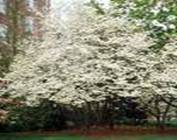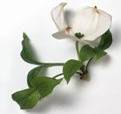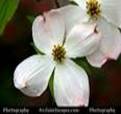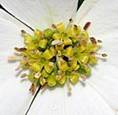| Kingdom | Plantae |
| Division | Magnoliophyta |
| Class | Magnoliopsida |
| Order | Cornales |
| Family | Cornaceae |
| Genus | Cornus |
| Species | C. florida |
| Binomial name | Cornus florida |
Other Common Names:
The other common names for the shrub dog wood are American Dogwood,Boxwood,Cornelian Tree, Dog Tree, False Box, Florida Dogwood, Flowering Dogwood, Green Ozier, Virginia Dogwood,Cornus white cornel, Indian arrow wood and nature's-mistake.
History
The beautiful white bloom of the dogwood is one of the first signs of spring in East Texas forests. The flowering dogwood is known for its spring display of blooms which cover the branches for at least two weeks, depending upon the weather.

Description
The dogwood sometimes grows to a height of 40 feet, but more frequently is a shrub. It has a short trunk and a full, rounded crown with horizontal branches often in layered tiers, spreading wider than its height. In the early spring the naked, leafless branches support numerous large, showy white flowers, so-called. The four showy parts of these "flowers" are petal like bracts which surround the true flowers, which are small, greenish-yellow, and inconspicuous.



Range
It is a native to the eastern and central United States. The range of flowering dogwood extends from extreme southwestern Maine west to New York, extreme southern Ontario, central Michigan, central Illinois, and central Missouri; south to extreme southeast Kansas, eastern Oklahoma, east Texas; and east to north Florida.
Habitat
Flowering dogwood grows best in moist soils, but will grow in drier habitats. They like to grow in the shade of larger trees as understory plants. Flowering dogwood grows well on flats and on lower or middle slopes, but not very well on upper slopes and ridges. The species grows on soils varying from deep and moist along minor streams to light textured and well drained in the uplands. It is found most frequently on soils with a pH of 6 to 7.
Cultivation
Flowering Dogwood prefers partial shade to full sun, moist to dry-mesic conditions, and soil containing loam, clay-loam, or some rocky material. Seed are sown as soon as it is ripe in a cold frame or in an outdoors seedbed if there is sufficient seed. The seed must be separated from the fruit flesh since this contains germination inhibitors. Stored seed should be cold stratified for 3 - 4 months and sown as early as possible in the year. Scarification may also help as may a period of warm stratification before the cold stratification. Germination, especially of stored seed, can be very slow, taking 18 months or more. Prick out the seedlings of cold-frame sown seeds into individual pots as soon as they are large enough to handle and grow the plants on for their first winter in a greenhouse, planting out in the spring after the last expected frosts. Cuttings of half-ripe side shoots take place in July or August in a frame and layering of new growth in June to July. Established specimens are tolerant of normal dry periods, but will need supplemental watering during extreme droughts. Stress of any kind makes dogwoods susceptible to diseases. It is best transplanted at a small size can be slow to re-establish following transplanting.
Flowering Season
The bloom time will vary depending upon the location. In the south they begin to bloom in March or April, whereas the northern states won't see blooms until May or June.
Pests and Diseases
Flowering dogwood is seriously threatened by a powerful fungus, Discula destructiva, or dogwood anthracnose. This fungus is spreading rapidly throughout the range of dogwood. The disease, whose origin is unknown, kills within two to three years of initial infection. Dogwood in moist sites on lower slopes and bottomlands are most susceptible. Some scientists feel that the blight is so widespread that they hold little hope of saving flowering dogwood in the wild. Other damaging insects include flatheaded borers (Chrysobothris azurea and Agrilus cephalicus), dogwood twig borer (Oberea tripunctata), the twig girdler (Oncideres cingulata), scurfy scale (Chionaspis lintneri), and dogwood scale.
Parts Used


The fruit and bark of the root is the most commonly used parts of the dogwood for its medicinal and commercial applications.
Medicinal Applications

• Dogwood is used in the treatment of various childhood diseases such as measles and worms.
• In early days a tea from dogwood bark is believed to reduce fevers and soothe colds.
• It is used to restore tone to the stomach in cases of alcoholism.
• It acts as Appetite stimulant.
• Dogwood is used in treating malaria and chronic diarrhoea.
• The bark has also been used as a poultice on external ulcers, wounds etc.
Commercial Applications

• Flowering dogwood has been used to make scarlet dyes and tinctures.
• The wood of the dogwood tree is used today to make small tools and ornaments.
• Flowering dogwoods are extremely valuable for wildlife because the seed, fruit, flowers, twigs, bark, and leaves are utilized as food by various animals.
• It is used in the manufacture of shuttles for textile weaving.
• The peeled twigs are used as toothbrushes for whitening the teeth and hardening the gums.
• It is used as a quinine substitute.
• The hard, dense wood has been used for products such as golf club heads, mallets, wooden rake teeth, tool handles, jeweller's boxes and butcher's blocks.
• The bark is very bitter, could it be used to make an insect or bird repellent.

Dogwood is declared as the state plant by the Virginians. One early native, George Washington, noted in his diary in 1785 that "a circle of dogwood" had been planted "close to the old cherry near the south garden house." Thomas Jefferson, another famous Virginian, known for his impeccable taste and appreciation of beautiful things, planted dogwood near his cherished home, Monticello.
It has a roughly textured bark that is said to resemble an alligator's skin and a shape that can stand alone in a winter landscape. When the Romans came to rule over Jerusalem, their government used this same timber to build the crosses for executing criminals. Dogwood has nothing to do with dogs. The wood is hard and was used to make skewers, known as "dags" which is called as dagwood.